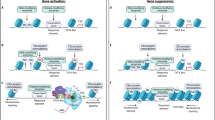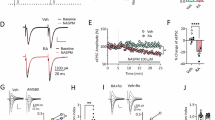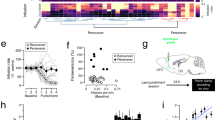Abstract
Homer proteins modulate neuroplasticity in excitatory synapses and are dynamically regulated by cocaine. Whereas acute cocaine elevates immediate-early gene (short) isoforms of Homer1 in the nucleus accumbens, withdrawal from repeated cocaine administration downregulates the expression of constitutive Homer1 isoforms. The present study determined whether or not this downregulation in constitutive Homer expression in the accumbens is necessary for enduring alterations in cocaine-induced changes in the brain and behavior. The long vs short Homer isoforms were overexpressed in the rat nucleus accumbens during drug abstinence, and the adaptations elicited by repeated cocaine on glutamate transmission and motor behavior were measured. It was found that both chronic and acute overexpression of constitutive, but not short, Homer isoforms abolished cocaine-induced sensitization of locomotor hyperactivity and prevented the development of glutamate abnormalities in the accumbens, including the reduction in basal extracellular glutamate content and the sensitized glutamate response to a subsequent cocaine challenge injection. Together, these data indicate that the enduring reduction of long Homer isoforms in the nucleus accumbens of cocaine-withdrawn rats is necessary for the expression of cocaine-induced neuroplasticity.
Similar content being viewed by others
Log in or create a free account to read this content
Gain free access to this article, as well as selected content from this journal and more on nature.com
or
References
Abe H, Misaka T, Tateyama M, Kubo Y (2003). Effects of coexpression with Homer isoforms on the function metabotropic glutamate receptor 1alpha. Mol Cell Neurosci 23: 157–168.
Ammon S, Mayer P, Riechert U, Tischmeyer H, Hollt V (2003). Microarray analysis of genes expressed in the frontal cortex of rats chronically treated with morphine and after naloxone precipitated withdrawal. Brain Res Mol Brain Res 112: 113–125.
Baker DA, McFarland K, Lake RW, Shen H, Tang XC, Toda S et al (2003). Neuroadaptations in cystine–glutamate exchange underlie cocaine relapse. Nat Neurosci 6: 743–749.
Baker DA, Xi ZX, Shen H, Swanson CJ, Kalivas PW (2002). The origin and neuronal function of in vivo nonsynaptic glutamate. J Neurosci 22: 9134–9143.
Bottai D, Guzowski JF, Schwarz MK, Kang SH, Xiao B, Lanahan A et al (2002). Synaptic activity-induced conversion or intronic to exonic sequence in Homer 1 immediate early gene expression. J Neurosci 22: 167–175.
Bowers MS, Lake RW, Rubinchik S, Dong JY, Kalivas PW (2003). Elucidation of Homer 1a function in the nucleus accumbens using adenovirus gene transfer technology. Ann NY Acad Sci 1003: 419–421.
Brakeman PR, Lanahan AA, O'Brien R, Roche K, Barnes CA, Huganir RL et al (1997). Homer: a protein that selectively binds metabotropic glutamate receptors. Nature 386: 221–223.
Clark KR, Liu X, McGrath JP, Johnson PR (1999). Highly purified recombinant adeno-associated virus vectors are biologically active and free of detectable helper and wild-type viruses. Hum Gene Ther 10: 1031–1039.
Cochran SM, Fujimura M, Morris BJ, Pratt JA (2002). Acute and delayed effects of phencyclidine upon mRNA levels of markers of glutamatergic and GABAergic neurotransmitter function in the rat brain. Synpase 46: 206–214.
de Bartolomeis A, Aloj L, Ambesi-Impiombato A, Bravi D, Curaco C, Muscettola G et al (2002). Acute administration of antipsychotics modulates Homer striatal gene expression differentially. Brain Res Mol Brain Res 98: 124–129.
de Bartolomeis A, Iasevoli F (2003). The Homer family and the signal transduction system at glutamatergic postsynaptic density: potential role in behavior and pharmacotherapy. Psychopharmacol Bull 37: 51–83.
During MJ, Young D, Baer K, Lawlor P, Klugmann M (2003). Development and optimization of adeno-associated virus vector transfer into the central nervous system. Methods Mol Med 76: 221–236.
Fagni L, Worley PF, Ango F (2002). Homer as both a scaffold and transduction molecule. Sci STKE 137: RE8.
Fujiyama K, Kajii Y, Hiraoka S, Nishikawa T (2003). Differential regulation by stimulants of neocortical expression of mrt1, arc, and homer1a mRNA in the rats treated with repeated methamphetamine. Synapse 49: 143–149.
Ghasemzadeh MB, Permenter LK, Lake R, Worley PF, Kalivas PW (2003). Homer1 proteins and AMPA receptors modulate cocaine-induced behavioural plasticity. Eur J Neurosci 18: 1645–1651.
Glick SD, Carlson JN (1989). Regional changes in brain dopamine and serotonin metabolism induced by conditioned circling in rats: effects of water deprivation, learning and individual differences in asymmetry. Brain Res 504: 231–237.
Hauck B, Chen L, Xiao W (2003). Generation and characterization of chimeric recombinant AAV vectors. Mol Ther 7: 419–425.
He D-Y, Vagts AJ, Yaka R, Ron D (2002). Ethanol induces gene expression via nuclear compartmentalization of Receptor Activated C Kinase I. Mol Pharmacol 62: 272–280.
Hennou S, Kato A, Schneider EM, Lundstrom K, Gahwiler BH, Inokuchi K et al (2003). Homer-1a/Vesl-1S enhances hippocampal synaptic transmission. Eur J Neurosci 18: 811–819.
Hwang SY, Wei J, Westhoff JH, Ducan RS, Ozawa F, Volpe P et al (2003). Differential functional interaction of two Vesl/Homer protein isoforms with ryanodine receptor type 1: a novel mechanism for control of intracellular calcium signaling. Cell Calcium 34: 177–184.
Kalivas PW, Volkow N, Seamans J (2005). Unmanageable motivation in addiction: a pathology in prefrontal-accumbens glutamate transmission. Neuron 45: 647–650.
Kammermeier PJ, Xiao B, Tu JC, Worley PF, Ikeda SR (2000). Homer proteins regulate coupling of group I metabotropic glutamate receptors to N-type calcium and M-type potassium channels. J Neurosci 20: 7238–7245.
Kato A, Ozawa F, Saitoh Y, Fukazawa Y, Sugiyama H, Inoduchi K (1998). Novel members of the Vesl/Homer family of PDZ proteins that bind metabotropic glutamate receptors. J Biol Chem 273: 23969–23975.
Klugmann M, Wymond Symes C, Leichtlein CB, Klaussner BK, Dunning J, Fong D et al (2005). AAV-mediated hippocampal expression of short and long Homer 1 proteins differentially affect cognition and seizure activity in adult rats. Mol Cell Neurosci. 28: 347–360.
Nagahara H, Vocero-Akbani AM, Snyder EL, Ho A, Latham DG, Lissy NA et al (1998). Transduction of full-length TAT fusion proteins into mammalian cells: TAT-p27Kip1 induces cell migration. Nat Med 4: 1449–1452.
Naisbitt S, Kim E, Tu JC, Xiao B, Sala C, Valtschanoff J et al (1999). Shank, a novel family of postsynaptic density proteins that binds to the NMDA receptor/PSD-95/GKAP complex and cortactin. Neuron 23: 569–582.
Nichols CD, Garcia EE, Sanders-Bush E (2003). Dynamic changes in prefrontal cortex gene expression following lysergic acid diethylamide administration. Brain Res Mol Brain Res 111: 182–188.
Nichols CD, Sanders-Bush E (2002). A single dose of lysergic acid diethylamide influences gene expression patterns within the mammalian brain. Neuropsychopharmacology 26: 634–642.
Paxinos G, Watson C (1986). The Rat Brain in Stereotaxic Coordinates. Academic Press: New York.
Pierce RC, Kalivas PW (1997). A circuitry model of the expression of behavioral sensitization to amphetamine-like psychostimulants. Brain Res Rev 25: 192–216.
Polese D, Amato de Serpis A, Ambesi-Impiombato A, Muscettola G, de Bartolomeis A (2002). Homer 1a gene expression modulation by antipsychotic drugs: involvement of the glutamate metabotropic system and effects of D-cycloserine. Neuropsychopharmacology 27: 906–913.
Robinson TE, Berridge KC (2003). Addiction. Annu Rev Psychol 54: 25–53.
Rong R, Ahn JY, Huang H, Nagata E, Kalman D, Kapp JA et al (2003). PI3 kinase enhancer-Homer complex couples mGluRI to PI3 kinase, preventing neuronal apoptosis. Nat Neurosci 6: 1153–1161.
Sala C, Futai K, Yamamoto K, Worley PF, Hayashi Y, Sheng M (2003). Inhibition of dendritic spine morphogenesis and synaptic transmission by activity-inducible protein Homer1a. J Neurosci 23: 6327–6337.
Shiraishi Y, Mizutani A, Mikoshiba K, Furuichi T (2003a). Coincidence in dendritic clustering and synaptic targeting of homer proteins and NMDA receptor complex proteins NR2B and PSD95 during development of cultured hippocampal neurons. Mol Cell Neurosci 22: 188–201.
Shiraishi Y, Mizutani A, Yuasa S, Mikoshiba K, Furuichi T (2003b). Glutamate-induced declustering of post-synaptic adaptor protein Cupidin (Homer 2/vesl-2) in cultured cerebellar granule cells. J Neurochem 87: 364–376.
Shiraishi Y, Mizutani A, Yuasa S, Mikoshiba K, Furuichi T (2004). Differential expression of Homer family proteins in the developing mouse brain. J Comp Neurol 473: 582–599.
Swanson C, Baker D, Carson D, Worley P, Kalivas PW (2001). Repeated cocaine administration attenuates group I metabotropic glutamate receptor-mediated glutamate release and behavioral activation: A potential role for Homer 1b/c. J Neuroscience 21: 9043–9052.
Szumlinski KK, Dehoff MH, Kang SH, Frys KA, Lominac KD, Klugmann M et al (2004a). Homer proteins regulate sensitivity to cocaine. Neuron 43: 401–413.
Szumlinski KK, Frys KA, Kalivas PW (2004b). Dissociable roles for the dorsal and median raphe in the facilitatory effect of 5-HT1A receptor stimulation upon cocaine-induced locomotion and sensitization. Neuropsychopharmacology 29: 1675–1687.
Szumlinski KK, Lominac KD, Kleschen MJ, Oleson EB, Dehoff MH, Schwartz MK et al (2005a). Behavioral and neurochemical phenotyping of Homer1 mutant mice: possible relevance to schizophrenia. Genes Brain Behav 4: 273–288.
Szumlinski KK, Lominac KD, Oleson EB, Walker JK, Mason A, Dehoff MH et al (2005b). Homer2 is necessary for EtOH-induced neuroplasticity. J Neurosci 25: 7054–7061.
Tu JC, Xiao B, Yuan JP, Lanahan AA, Leoffert K, Li M et al (1998). Homer binds a novel proline-rich motif and links group 1 metabotropic glutamate receptors with IP3 receptors. Neuron 21: 717–726.
Tu JC, Xiao B, Naisbitt S, Yuan JP, Petralia RS, Brakeman P et al (1999). Coupling of mGluR/Homer and PSD-95 complexes by the Shank family of postsynaptic density proteins. Neuron 23: 583–592.
Xiao B, Tu JC, Petralia RS, Yuan JP, Doan A, Breder CD et al (1998). Homer regulates the association of group 1 metabotropic glutamate receptors with multivalent complexes of homer-related, synaptic proteins. Neuron 21: 707–716.
Vagts AJ, He DY, Yaka R, Ron D (2003). Cellular adaptation to chronic ethanol results in altered compartmentalization and function of the scaffolding protein RACK1. Alcohol Clin Exp Res 27: 1599–1605.
Wolf ME (1998). The role of excitatory amino acids in behavioral sensitization to psychomotor stimulants. Prog Neurobiol 54: 679–720.
Yuan JP, Kiselyov K, Shin DM, Chen J, Shcheynikov N, Kang SH et al (2003). Homer binds TRPC family channels and is required for gating of TRPC1 by IP3 receptors. Cell 114: 777–789.
Acknowledgements
We acknowledge NIDA for the generous gift of cocaine. This work was supported, in part, by grants from NIDA (DA-03906, DA-14185) to PWK and funds provided by the State of California for medical research on alcohol and substance abuse through the University of California, San Francisco to DR. KKS was supported, in part, by a postdoctoral fellowship from the CIHR.
Author information
Authors and Affiliations
Corresponding author
Rights and permissions
About this article
Cite this article
Szumlinski, K., Abernathy, K., Oleson, E. et al. Homer Isoforms Differentially Regulate Cocaine-Induced Neuroplasticity. Neuropsychopharmacol 31, 768–777 (2006). https://doi.org/10.1038/sj.npp.1300890
Received:
Accepted:
Published:
Issue date:
DOI: https://doi.org/10.1038/sj.npp.1300890
Keywords
This article is cited by
-
mGlu1 and mGlu5 modulate distinct excitatory inputs to the nucleus accumbens shell
Neuropsychopharmacology (2018)
-
Glutamate delta-1 receptor regulates cocaine-induced plasticity in the nucleus accumbens
Translational Psychiatry (2018)
-
Chikusetsu saponin IVa confers cardioprotection via SIRT1/ERK1/2 and Homer1a pathway
Scientific Reports (2015)
-
Synaptic depression via mGluR1 positive allosteric modulation suppresses cue-induced cocaine craving
Nature Neuroscience (2014)
-
Requirement of the immediate early gene vesl-1S/homer-1a for fear memory formation
Molecular Brain (2009)



